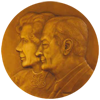
Börje haraldsson, professor of Nephrology at the University of Gothenburg and chief physician at Sahlgrenska University Hospital. He dreams of finding a curative treatment for advanced kidney cancer. NOTE – This article is machine translated from Swedish.
With the help of a substance from the infamous fungus Sierra giftspindling develop researchers in Gothenburg a treatment of severe kidney cancer. Börje haraldsson and his colleagues discovered by accident that the fungus poison can kill cancer cells.
Sierra giftspindling (Cortinarius rubellus) picked sometimes mistakenly confused with chanterelles. If you ingest the poison mushroom, orellanin, it leads to an incurable kidney damage, but it affects other organs of the body. In an attempt to find the antidote discovered Börje h this gift also absorbed by the kidney cancer cells.
“We have identified how the poison seems, it closes, among other things, of the cellular defense systems. Now we try to find exactly which of the kidneys ‘ many specific transporters responsible for absorption of fungus poison. We have seen in studies of orellanin is effective against both human renal cancer in cell culture and in rodents.
Börje Harold’s research team hopes to test its proprietary concept in patients within two years. However, the leading treatment for dialysis-dependent.
— Unless we can take out a healthy kidney, keep running it and restocking the person’s own kidney after finishing cancer treatment, he adds, and smiles when I wonder how far away he looks then.
The fact is that today makes similarly with lungs, so utterly remote is not possible.
It’s a dream come true for Börje haraldsson to offer people suffering from advanced kidney cancer a curative treatment. Each year, about a thousand Swedes are diagnosed with kidney cancer, of which just over 600 already have or get metastases.
— So far there is no effective treatment and on average are survival rates less than 12 months. We believe that patients can be cured of kidney cancer with our method and then become dialysis an acceptable side effect of the treatment.
For this research work will grant from Lundberg Foundation at just the right time. They can soon buy an advanced analysis equipment needed to be able to provide just the right giftdos to the patients. The same equipment can also be used for other treatments, when you want to trace proteins in urine.
— Another of our projects to understand more about kidney disease, Glomerulonephritis. By identifying signaling pathways inside cells, we have seen that some medical conditions caused the cells to send error information between themselves. With the knowledge we have in experiments have been able to stop the development of the disease. It is hoped that these studies will lead to new therapies.
Kidney disease affects relatively few people but the care of those who fall ill are very resource intensive. For some reason gets three times more men than women sick. Börje haraldsson likes to work clinically and prioritize their time with patients.
— Meeting with people affected by kidney disease is my source of inspiration. It becomes so clear that treatment modalities need to be improved.
In addition to efforts to develop new treatment methods he wants to deepen the understanding of the kidney’s intricate structure. Exactly how the filter works is a mystery that has captivated Börje haraldsson throughout his post-graduate life.
— Human kidneys cleanse 180 litres of blood plasma every day and the residue becomes the litres of urine you urinate every day. There is no filter in the world that is even close to the capacity of our kidneys are.
The filter, or the Glomerular barrier functions thanks to an ingeniously the interaction between cells in the kidney. It was knowledge on this interaction and endotelcellers importance as did Börje and Mrs Jenny Nyström internationally famous.
— Together with researchers in New York, we have recently been able to show that the different cell types in the kidney’s filters are inextricably linked and dependent on each other for continued survival. The Exchange with his colleagues in the United States became extra intense last year when he was a guest professor in Manhattan.
— At the clinic are more kidney researchers than we have in all the Nordic countries and they are passionate in their work. It was a luxury for me to devote myself to research 18 hours a day when I was there. I know it sounds geeky, but it’s my biggest hobby.
Börje haraldsson wish more took the chance to work abroad for a period.
— It is extremely rewarding.
Text and photo: Monica Havström
